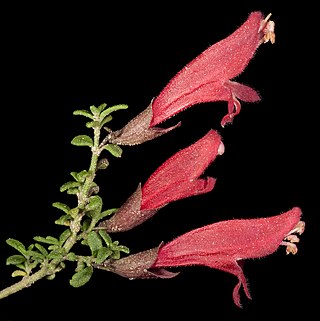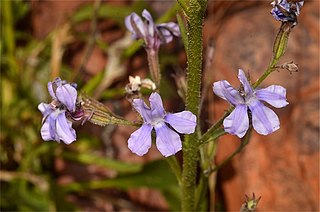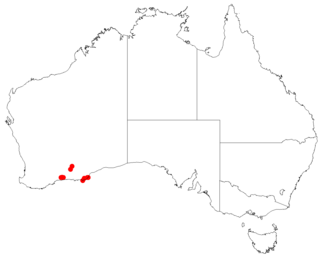Persoonia brachystylis is a species of flowering plant in the family Proteaceae and is endemic to a restricted area on the west coast of Western Australia. It is an erect, spreading shrub with smooth bark, narrow spatula-shaped to lance-shaped leaves and yellow flowers in groups of ten to twenty.

Seringia hermanniifolia, commonly known as crinkle-leaved firebush, is a species of flowering plant in the mallow family and is endemic to the south-west of Western Australia. It is a low-growing or prostrate, suckering shrub with hairy new growth, hairy, wavy, oblong to egg-shaped leaves and mauve to bluish flowers arranged in groups of 3 to 8.
Hypocalymma longifolium, commonly known as long-leaved myrtle, is a species of flowering plant in the myrtle family Myrtaceae, and is endemic to a restricted part of Western Australia. It is an open shrub with linear leaves, and white or cream-coloured flowers arranged in pairs in leaf axils, with 40 to 50 stamens in several rows.

Conospermum canaliculatum is a species of flowering plant in the family Proteaceae, and is endemic to the south-west of Western Australia. It is a dense, multistemmed, erect shrub with linear leaves and spike-like panicles of woolly white, tube-shaped flowers.

Conospermum coerulescens is a species of flowering plant in the family Proteaceae and is endemic to the south of Western Australia. It is an erect shrub with thread-like to narrowly lance-shaped leaves and spikes of up to 10 greyish-blue to deep blue, hairy flowers.

Conospermum croniniae is a species of flowering plant in the family Proteaceae and is endemic to the south-west of Western Australia. It is an erect, open shrub with spreading cylindrical leaves and spikes of up to 6 pale blue or pink, tube-shaped, hairy flowers.

Conospermum eatoniae, commonly known as blue lace, is a species of flowering plant in the family Proteaceae and is endemic to the south-west of Western Australia. It is a spreading shrub with egg-shaped leaves only present on young plants, and panicles of glabrous blue, tube-shaped flowers with pale green bracteoles.

Conospermum flexuosum, commonly known as the tangled smokebush, is a species of flowering plant in the family Proteaceae and is endemic to the south-west of Western Australia. It is a sprawling shrub with many zig-zag branches, panicles of white to pale blue, tube-shaped flowers and urn-shaped, hairy nuts.

Conospermum leianthum is a species of flowering plant in the family Proteaceae and is endemic to the south-west of Western Australia. It is a shrub with thread-like leaves, and panicles of white and more or less purple, tube-shaped flowers.
Conospermum microflorum is a species of flowering plant of the family Proteaceae and is endemic to Western Australia. It is a rounded shrub with glabrous, thread-like leaves, panicles of woolly hairy, white or cream coloured flowers and woolly hairy, orange-brown nuts.

Conospermum spectabile is a species of flowering plant in the family Proteaceae and is endemic to the south-west of Western Australia. It is an erect, compact shrub with S-shaped leaves that are circular in cross section, and panicles of woolly white and blue, tube-shaped flowers.

Prostanthera canaliculata is a species of flowering plant in the family Lamiaceae and is endemic to the south-west of Western Australia. It is a small, erect shrub with hairy branchlets, narrow egg-shaped to narrow elliptical leaves and pale blue or pale violet to white flowers with no markings.

Prostanthera grylloana is a species of flowering plant in the family Lamiaceae and is endemic to Western Australia. It is a small, erect shrub with densely hairy branchlets, small, spatula-shaped leaves and red to pink flowers.

Goodenia ramelii is a species of flowering plant in the family Goodeniaceae and is endemic to central Australia. It is a perennial herb with toothed, elliptic leaves in a rosette at the base of the plant, and racemes of blue flowers.
Pomaderris forrestiana is a species of flowering plant in the family Rhamnaceae and is endemic to south-western Australia. It is a low shrub with elliptic leaves, and small clusters of woolly-hairy flowers.

Lasiopetalum oppositifolium is a species of flowering plant in the family Malvaceae and is endemic to the south-west of Western Australia. It is an open, erect shrub with rusty-hairy young stems, linear, narrowly elliptic or narrowly egg-shaped leaves and white, pink and dark red flowers.

Leucopogon bossiaea is a species of flowering plant in the heath family Ericaceae and is endemic to a restricted area in the south-west of Western Australia. It is an erect shrub with elliptic to broadly egg-shaped leaves and white flowers in four to eleven upper leaf axils.
Pimelea holroydii is a species of flowering plant in the family Thymelaeaceae and is endemic to the north of Western Australia. It is an erect shrub with egg-shaped leaves arranged more or less in opposite pairs, and head-like clusters of white or cream-coloured, tube-shaped flowers.

Pimelea spiculigera is a species of flowering plant in the family Thymelaeaceae and is endemic to Western Australia. It is an erect shrub with linear to narrowly egg-shaped leaves and heads of yellow or greenish-yellow flowers surrounded by 2 or 4 egg-shaped involucral bracts.

Goodenia exigua is a species of flowering plant in the Goodeniaceae family and is endemic to the south of Western Australia. It is a stoloniferous, perennial plant with whorls of spatula-shaped leaves and yellow flowers.















